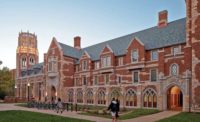"Federal and military work is typically design-build, so we can easily apply that experience to other market sectors," Peele says, noting North Carolina's recent authorization of design-build for public projects.
"It also helps with the increasing cross-pollination of projects," she adds, "such as university housing projects incorporating retail and dining elements."
Intra-firm information exchanges are also essential when it comes to sustainability. LS3P's portfolio already includes more than 13 million sq ft of LEED-certified projects.
LS3P's Green Core Competency Board, made up of representatives from all six offices, helps keep the firm's 122 LEED-accredited design professionals up on the latest trends and practices. In addition, the firm has adopted AIA's 2030 Commitment, which is focused on reducing building energy consumption, lowering greenhouse gas emissions, conserving water and improving air quality for all buildings.
"Most clients come in with good ideas of goals," Peele says. "Instead of having to educate them about sustainability, it's up to architects now to choose strategies that are appropriate to their budgets and aspirations."
Moreover, buildings are increasingly called on to serve more than conventional "type-specific" functions. For example, higher-education residence halls must now include food service and retail elements. Growing interest in live/work/play environments means office buildings must offer a variety of amenities so that workers need not use their cars during the day, says John Harris, president and CEO of Charlotte-based commercial developer Lincoln-Harris. Harris has worked with LS3P on a variety of projects.
Still, Harris notes, it's possible to have all this functionality and also meet stylistic preferences. "We prefer classic, Jeffersonian-inspired exteriors distinguished by brick and distinct lines," he says. "LS3P has gone out of their way to help us find ways to create these kinds of environments within the same classic envelope. Yet when our clients have asked us to do something in concrete or glass, LS3P has been good at helping us with those styles as well."
LS3P recognizes when it too needs to change. After its 50th anniversary last year, the firm reorganized with new strategic and evolutionary plans centered around both business and practice, each of which is overseen by an executive vice president.
Penney also emphasizes the value of fostering communication and information-sharing. In 2011, he hired New York-based consultant Graceworks to conduct a communication skills workshop. The workshop proved so successful that he and his wife, also an architect, sponsored a similar program for graduate students at Clemson, their alma mater.
"Architecture is a 'team sport' now, yet much of an architect's course of study is focused on visual communication," Penney says. "Since verbal communication skills are so important, whether interviewing for a new commission, 'selling' a design, presenting to a regulatory body or simply communicating with the design team, we thought it may be a great addition to their course of study."
CU-ICAR's Boyette agrees. "You still encounter architects who just don't listen to the client," he says. "We never had that problem with LS3P. They make a consistent effort to be considerate of the client's needs and keep the budget balanced."
LS3P's communication skills proved helpful in designing the new $30-million, 90,000-sq ft Nursing and Science Building at Trident Technical College, North Charleston, S.C., which opened earlier this year.









